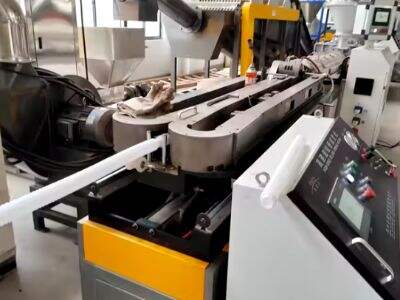Did you ever wonder how plastic pipes are made? We can find them in our houses and on the roads. We here at Fosita Specialized in this process of making these plastic pipes with a special kind technique bundle is called extrusion. We use this method for making pipes and tubes, which are available in thousands of shapes.
What is Plastic Extrusion?
Extrusion is used for a variety of processes to make things with plastic. It begins with unprocessed plastic—small pellets called resin or powder, for example. Let's start by running the raw materials through a machine. Next, we bake the rubber over a flame until it melts into gooey state. After this is melted, we force it through a die — essentially any shape you can think of. The die shapes the melted plastic into a pipe. This is the way by which we can manufacture pipes of different dimensions to channelize liquid, gaseous and half-liquid/half-solid substances.
What Is The Function Of Plastic Pipe Machines?
Several steps in making of plastic pipes that other machines, Plastic pipe extrusion machine is designed for its work. There are different components that come together when piping is created. The crucial parts of the Plastic pipe making machine are given here:
Hopper— This is the opening that gets fed by gravity from a giant slinky of plastic pellets. Consider it the entry point for raw materials.
Extruder — This is a long, heated part of the Plastic pipe machine where the plastic pellets are melted. Once the plastic is heated enough it turns into a very thick liquid.
Die— A part that produces the melted plastic in order to form the pipe. It appears to be stone form from which the pipe is extruded.
Cooling System— The plastic pipe comes out of the die and is hard for it to keep its shape. That cooling system right there helps a bit with it.
Cutting Device — When we need the pipes to be smaller in size, a cutting device is utilized for reducing them into appropriate lengths.
The Technology Behind Plastic Pipe Manufacturing
Some users think that to produce plastic pipes is simple and, in fact peculiarly enough — it should be made correctly. This process is quite interesting science.
One key thing to keep in mind here is the temperature of plastic. Every plastic has an optimum temperature to which we heat it. The plastic quality can break down and thus lose its strength if it gets too hot. If the temperature is too low, though, you will only see melted plastic in a few areas. This is a problem as the plastic may not flow through into the die well and can lead to poorly shaped pipes.
Additionally, the pressure we need to push plastic through that flower pot. However, if we do not push enough capacity, the plastic might have issues filling it. This can turn into an unfinished or oddly shaped pipe. However, going too fast can lead to over stressing the plastic and it cracking or warping also. Balancing is important in producing pipes of good quality.
Plastic Pipe and New Tech
Here at Fosita, we take advantage of the newest technology to produce dependable and durable plastic pipes. So we have one of the advanced plastic pipe machine that also gives us full control over all stages in extrusion. This means we can change the temperature, pressure and velocity to make sure our pipes are made perfectly every time.
The other technique is co-extrusion. It is a neat trick to make dual or even multi-layered plastic pipes all at once. Since each individual layer can have other properties, this makes it possible to create pipes with more strength, or longer durability and withstand certain chemicals or environments. With this added strength and utility, our pipes helps invaluable for a variety of applications.
All in all, the plastic pipe extrusion is an intelligent method that can manufacture solid pipes out of plastics. At Fosita, we are committed to using the best technology and techniques to manufacture high-quality pipes that can function well. So, the next time you come across a plastic pipe may it be at your home or on street outside just remember how and from what it’s made of.

 EN
EN
 AR
AR
 FR
FR
 HI
HI
 PT
PT
 RU
RU
 ES
ES
 TL
TL
 ID
ID
 UK
UK
 VI
VI
 SQ
SQ
 TH
TH
 TR
TR
 FA
FA
 MS
MS
 SW
SW
 BE
BE
 HY
HY
 AZ
AZ
 KA
KA
 UR
UR
 BN
BN
 KM
KM
 LO
LO
 LA
LA
 NE
NE
 ZU
ZU
 MY
MY
 KK
KK
 ML
ML
 SI
SI
 TG
TG
 UZ
UZ
 AM
AM
 KU
KU
 KY
KY
 PS
PS
 SD
SD
 XH
XH

